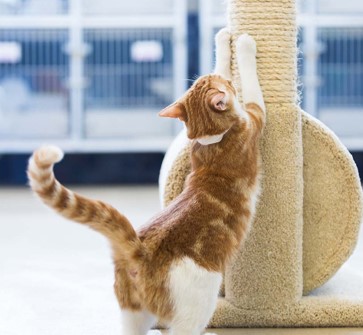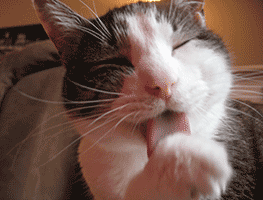Scratching and Clawing
 Scratching is a natural and necessary behavior for cats. It is as instinctual for cats to scratch as it is for them to groom themselves or hunt prey. Although it is undesirable when directed on furniture or carpets, it is not a behavior to discourage. Instead, it should be redirected towards appropriate areas.
Scratching is a natural and necessary behavior for cats. It is as instinctual for cats to scratch as it is for them to groom themselves or hunt prey. Although it is undesirable when directed on furniture or carpets, it is not a behavior to discourage. Instead, it should be redirected towards appropriate areas.
Cats scratch for multiple reasons. It removes the dead outer layer of their claws, allows their bodies to stretch and flex, is an outlet for physical exercise, and allows them to scent-mark territory using the glands in their paws. Giving your cat appropriate items to scratch and encouraging the behavior on designated surfaces will help your cat live a full and enriched life.
Identify your cat’s scratching preference
Start by examining what surfaces your cat is choosing to scratch on. Many cats have preferences when it comes to the surface type and location of the item. Does your cat choose wooden trim? The carpet? A corner of your fabric couch? Do they scratch the flooring or choose an upright surface like a door frame?
Now that you have identified what they prefer, choose the appropriate scratching post to align with their preference. Scratching posts come in a variety of material such as rope, carpet, cardboard, etc., which allows you to choose the right surface for your cat. Scratching posts can be upright, at an angle, or flat on the floor. For upright or angled scratching posts, they must be taller than your cat is when they are on their hind legs so they have room to stretch as they scratch. Larger cats will need larger scratching posts. If the post isn’t tall enough, it won’t be an appealing option to your cat. Scratching posts should also be sturdy so your cat can’t tip it over while scratching, so look for designs with a wide base. If it tips over during use, it may scare your cat and stop them from using it again in the future. Check out our online store or stop in at any WHS sheltering location to see what scratching posts and cat condos we have available. Besides competitive prices and a quality selection, 100% of the proceeds from your purchase will go straight to the animals at the Wisconsin Humane Society.
Choosing a location for the scratching post
Once you have chosen the scratching post that matches your cat’s preferences, choose the appropriate location to place it in your home. To start with, place the scratching post as closely as possible to their original scratching spot. For example, set the post right next to the arm of the couch, or place the scratching board on the ground near their favorite scratching spot on the carpet. If your cat was scratching in multiple locations, it’s best to put a post by each location.
Once your cat is using the new scratching object consistently and stops clawing the old, you can begin to slowly move the scratching post to a new location, if needed. It should be moved very gradually (ex., slide it a foot or two each day) or ideally kept near the previously preferred item whenever possible. For example, if your cat was scratching doorways, keep the scratching post as near to a doorway as possible. Generally, cats choose to scratch in high-traffic areas, so resist the urge to move the post to an unused room or back hallway unless your cat was using those areas previously for scratching.
Making the inappropriate surface unappealing
In addition to providing the ideal scratching space for your cat, you can make the inappropriate surface undesirable. Cover their old scratching spots with materials that aren’t appealing to scratch. For example, use aluminum foil or double-sided sticky tape on couch corners, or place a rug liner on top of the flooring your cat was scratching (or in front of the area where your cat was scratching).
Leave the deterrents on the items until your cat has begun using the provided scratching posts consistently and you have moved them to their final location. Once they’ve been successful for a month, gradually remove the deterrents on the old objects. If the cat begins to revert to their old ways, immediately replace the deterrents and leave them up for a longer stretch of time.
Increasing mental and physical exercise
Scratching is a form of exercise and a way for cats to release energy. Some cats will also scratch when bored. Increasing their daily mental and physical exercise will give them other outlets for their energy, as well as provide them different items and objects to engage with if bored. If your cat is playing with a treat dispensing toy, they cannot be simultaneously scratching. Check out our resource on cat enrichment for ideas and ways to promote more mental and physical engagement in your cat’s life.
Trimming nails consistently
One way to minimize damage to inappropriate scratching spots and prolong the life of intended clawing objects is to trim your cat’s nails on a routine basis. Check out our resource on nail trimming to learn how to slowly acclimate your cat to the process and help them enjoy their weekly manicure.
Alternatives to declawing
The Wisconsin Humane Society strongly discourages people from having their cats declawed. Declawing is the act of removing the last digit of a cat’s toe which includes their nail. Scratching is a natural instinctual behavior for cats and is a necessary part of their daily life. Claws are also one of a cat’s main tools of self-defense, leaving some declawed cats feeling vulnerable and causing them to become mouthier or bite. Declawing can also change the way a litterbox feels to their paws and can be painful after surgery, causing them to stop using the litterbox consistently.
If you’ve taken all of the steps above but your cat doesn’t redirect to a new scratching object, you can try using Soft Claws. Soft Claws are vinyl nail covers that are placed over your cat’s nails with a non-toxic adhesive. Soft Claws can last anywhere from 4-6 weeks before needing to be replaced and allow your cat to “scratch” household items without causing damage. Soft Claws can be purchased at any of the Wisconsin Humane Society Campuses or at your local pet supply store.

